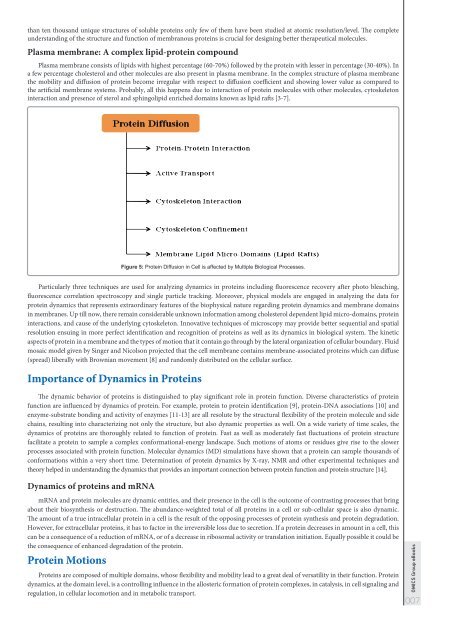You also want an ePaper? Increase the reach of your titles
YUMPU automatically turns print PDFs into web optimized ePapers that Google loves.
than ten thousand unique structures of soluble prote<strong>in</strong>s only few of them have been studied at atomic resolution/level. The complete<br />
understand<strong>in</strong>g of the structure and function of membranous prote<strong>in</strong>s is crucial for design<strong>in</strong>g better therapeutical molecules.<br />
Plasma membrane: A complex lipid-prote<strong>in</strong> compound<br />
Plasma membrane consists of lipids with highest percentage (60-70%) followed by the prote<strong>in</strong> with lesser <strong>in</strong> percentage (30-40%). In<br />
a few percentage cholesterol and other molecules are also present <strong>in</strong> plasma membrane. In the complex structure of plasma membrane<br />
the mobility and diffusion of prote<strong>in</strong> become irregular with respect to diffusion coefficient and show<strong>in</strong>g lower value as compared to<br />
the artificial membrane systems. Probably, all this happens due to <strong>in</strong>teraction of prote<strong>in</strong> molecules with other molecules, cytoskeleton<br />
<strong>in</strong>teraction and presence of sterol and sph<strong>in</strong>golipid enriched doma<strong>in</strong>s known as lipid rafts [3-7].<br />
Figure 5: Prote<strong>in</strong> Diffusion <strong>in</strong> Cell is affected by Multiple Biological Processes.<br />
Particularly three techniques are used for analyz<strong>in</strong>g dynamics <strong>in</strong> prote<strong>in</strong>s <strong>in</strong>clud<strong>in</strong>g fluorescence recovery after photo bleach<strong>in</strong>g,<br />
fluorescence correlation spectroscopy and s<strong>in</strong>gle particle track<strong>in</strong>g. Moreover, physical models are engaged <strong>in</strong> analyz<strong>in</strong>g the data for<br />
prote<strong>in</strong> dynamics that represents extraord<strong>in</strong>ary features of the biophysical nature regard<strong>in</strong>g prote<strong>in</strong> dynamics and membrane doma<strong>in</strong>s<br />
<strong>in</strong> membranes. Up till now, there rema<strong>in</strong> considerable unknown <strong>in</strong>formation among cholesterol dependent lipid micro-doma<strong>in</strong>s, prote<strong>in</strong><br />
<strong>in</strong>teractions, and cause of the underly<strong>in</strong>g cytoskeleton. Innovative techniques of microscopy may provide better sequential and spatial<br />
resolution ensu<strong>in</strong>g <strong>in</strong> more perfect identification and recognition of prote<strong>in</strong>s as well as its dynamics <strong>in</strong> biological system. The k<strong>in</strong>etic<br />
aspects of prote<strong>in</strong> <strong>in</strong> a membrane and the types of motion that it conta<strong>in</strong> go through by the lateral organization of cellular boundary. Fluid<br />
mosaic model given by S<strong>in</strong>ger and Nicolson projected that the cell membrane conta<strong>in</strong>s membrane-associated prote<strong>in</strong>s which can diffuse<br />
(spread) liberally with Brownian movement [8] and randomly distributed on the cellular surface.<br />
Importance of Dynamics <strong>in</strong> Prote<strong>in</strong>s<br />
The dynamic behavior of prote<strong>in</strong>s is dist<strong>in</strong>guished to play significant role <strong>in</strong> prote<strong>in</strong> function. Diverse characteristics of prote<strong>in</strong><br />
function are <strong>in</strong>fluenced by dynamics of prote<strong>in</strong>. For example, prote<strong>in</strong> to prote<strong>in</strong> identification [9], prote<strong>in</strong>-DNA associations [10] and<br />
enzyme-substrate bond<strong>in</strong>g and activity of enzymes [11-13] are all resolute by the structural flexibility of the prote<strong>in</strong> molecule and side<br />
cha<strong>in</strong>s, result<strong>in</strong>g <strong>in</strong>to characteriz<strong>in</strong>g not only the structure, but also dynamic properties as well. On a wide variety of time scales, the<br />
dynamics of prote<strong>in</strong>s are thoroughly related to function of prote<strong>in</strong>. Fast as well as moderately fast fluctuations of prote<strong>in</strong> structure<br />
facilitate a prote<strong>in</strong> to sample a complex conformational-energy landscape. Such motions of atoms or residues give rise to the slower<br />
processes associated with prote<strong>in</strong> function. Molecular dynamics (MD) simulations have shown that a prote<strong>in</strong> can sample thousands of<br />
conformations with<strong>in</strong> a very short time. Determ<strong>in</strong>ation of prote<strong>in</strong> dynamics by X-ray, NMR and other experimental techniques and<br />
theory helped <strong>in</strong> understand<strong>in</strong>g the dynamics that provides an important connection between prote<strong>in</strong> function and prote<strong>in</strong> structure [14].<br />
Dynamics of prote<strong>in</strong>s and mRNA<br />
mRNA and prote<strong>in</strong> molecules are dynamic entities, and their presence <strong>in</strong> the cell is the outcome of contrast<strong>in</strong>g processes that br<strong>in</strong>g<br />
about their biosynthesis or destruction. The abundance-weighted total of all prote<strong>in</strong>s <strong>in</strong> a cell or sub-cellular space is also dynamic.<br />
The amount of a true <strong>in</strong>tracellular prote<strong>in</strong> <strong>in</strong> a cell is the result of the oppos<strong>in</strong>g processes of prote<strong>in</strong> synthesis and prote<strong>in</strong> degradation.<br />
However, for extracellular prote<strong>in</strong>s, it has to factor <strong>in</strong> the irreversible loss due to secretion. If a prote<strong>in</strong> decreases <strong>in</strong> amount <strong>in</strong> a cell, this<br />
can be a consequence of a reduction of mRNA, or of a decrease <strong>in</strong> ribosomal activity or translation <strong>in</strong>itiation. Equally possible it could be<br />
the consequence of enhanced degradation of the prote<strong>in</strong>.<br />
Prote<strong>in</strong> Motions<br />
Prote<strong>in</strong>s are composed of multiple doma<strong>in</strong>s, whose flexibility and mobility lead to a great deal of versatility <strong>in</strong> their function. Prote<strong>in</strong><br />
dynamics, at the doma<strong>in</strong> level, is a controll<strong>in</strong>g <strong>in</strong>fluence <strong>in</strong> the allosteric formation of prote<strong>in</strong> complexes, <strong>in</strong> catalysis, <strong>in</strong> cell signal<strong>in</strong>g and<br />
regulation, <strong>in</strong> cellular locomotion and <strong>in</strong> metabolic transport.<br />
OMICS Group eBooks<br />
007



